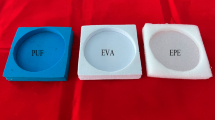Abstract
Cushioning buffers made of expandable polystyrene, a white polymeric granulated material, are commonly used to protect goods from damage. Current design practices tend to be simplistic and general, resulting in either overdesigned buffers or inadequate product protection. The objective of this paper is to identify the main parameters affecting shock absorption so that products can be better protected. An investigative study reveals that the types of impact surfaces, material densities, geometric features, and configurations contribute significantly to the amount of shock that a product experiences.
Similar content being viewed by others
References
J.F. Hanlon,Handbook of Package Engineering, McGraw-Hill, 1971
“Technical Information on Packaging with Expanded Styropor,” BASF, Ludwigshafen, Germany, 1978
S.W. Lye and H.K. Ho, Automated CAD Protective Packaging Design,Eng. Comput., No. 9, 1993, p 178–186
“Standard Test Methods for Mechanical-Shock Fragility of Products, Using Shock Machines,” D 3332,Annual Book of ASTM Standards, ASTM, 1988, p 493–497
Author information
Authors and Affiliations
Rights and permissions
About this article
Cite this article
Lye, S.W., Teo, M. & Lew, S.C. A study of shock characterization for protective packaging design. JMEP 4, 308–313 (1995). https://doi.org/10.1007/BF02649068
Published:
Issue Date:
DOI: https://doi.org/10.1007/BF02649068




